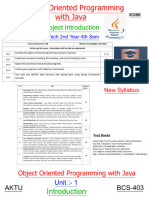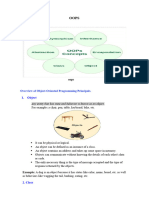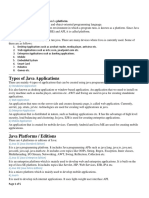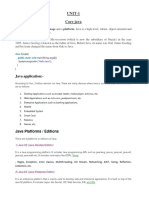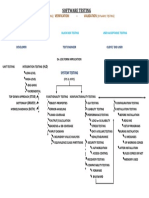Object Oriented Programming Using Java
Uploaded by
r.p.sujan838Object Oriented Programming Using Java
Uploaded by
r.p.sujan838www.ChaloExam.
com
Follow us on Instagram: @ChaloExam
www.ChaloExam.com
Page | 1
UNIT- I
Follow us on Instagram: @ChaloExam
www.ChaloExam.com
Page | 2
Basics of Java programming
Java is a programming language and a platform. Java is a high level, robust,
object-oriented and secure programming language.
Java was developed by Sun Microsystems (which is now the subsidiary of Oracle)
in the year 1995. James Gosling is known as the father of Java. Before Java, its
name was Oak. Since Oak was already a registered company, James Gosling and
his team changed the name from Oak to Java.
java Example
Let's have a quick look at Java programming examples. A detailed description of
the Hello Java example is available on the next page.
Simple.java
1. class Simple{
2. public static void main(String args[]){
3. System.out.println("Hello Java");
4. }
5. }
Follow us on Instagram: @ChaloExam
www.ChaloExam.com
Page | 3
Application
According to Sun, 3 billion devices run Java. There are many devices where Java
is currently used. Some of them are as follows:
1. Desktop Applications such as acrobat reader, media player, antivirus, etc.
2. Web Applications such as irctc.co.in, javatpoint.com, etc.
3. Enterprise Applications such as banking applications.
4. Mobile
5. Embedded System
6. Smart Card
7. Robotics
8. Games, etc.
Types of Java Applications
There are mainly 4 types of applications that can be created using Java
programming:
1 Standalone Application
Standalone applications are also known as desktop applications or window-based
applications. These are traditional software that we need to install on every
Follow us on Instagram: @ChaloExam
www.ChaloExam.com
Page |1
UNIT- II
Follow us on Instagram: @ChaloExam
www.ChaloExam.com
Page |2
INHERITANCE AND POLYMORPHISM
Inheritance in Java
Inheritance in Java is a mechanism in which one object acquires all the properties
and behaviors of a parent object. It is an important part of OOPs
(Object Oriented programming system).
The idea behind inheritance in Java is that you can create new classes that are
built upon existing classes. When you inherit from an existing class, you can reuse
methods and fields of the parent class. Moreover, you can add new methods and
fields in your current class also.
Inheritance represents the IS-A relationship which is also known as a parent-child
relationship.
Terms used in Inheritance
Class: A class is a group of objects which have common properties. It is a
template or blueprint from which objects are created.
Sub Class/Child Class: Subclass is a class which inherits the other class. It
is also called a derived class, extended class, or child class.
Super Class/Parent Class: Superclass is the class from where a subclass
inherits the features. It is also called a base class or a parent class.
Reusability: As the name specifies, reusability is a mechanism which
facilitates you to reuse the fields and methods of the existing class when
Follow us on Instagram: @ChaloExam
www.ChaloExam.com
Page |3
you create a new class. You can use the same fields and methods already
defined in the previous class.
The syntax of Java Inheritance
1. class Subclass-name extends Superclass-name
2. {
3. //methods and fields
4. }
The extends keyword indicates that you are making a new class that derives from
an existing class. The meaning of "extends" is to increase the functionality.
Exception Handling in Java
In the terminology of Java, a class which is inherited is called a parent or
superclass, and the new class is called child or subclass.
Java Inheritance Example
Follow us on Instagram: @ChaloExam
www.ChaloExam.com
Page |1
UNIT-III
Follow us on Instagram: @ChaloExam
www.ChaloExam.com
Page |2
EVENT AND GUI PROGRAMMING
Event Handling
Event and Listener (Java Event Handling)
Changing the state of an object is known as an event. For example, click on
button, dragging mouse etc. The java.awt.event package provides many event
classes and Listener interfaces for event handling.
Types of Event
The events can be broadly classified into two categories:
Foreground Events - Those events which require the direct interaction of
user.They are generated as consequences of a person interacting with the
graphical components in Graphical User Interface. For example, clicking on a
button, moving the mouse, entering a character through keyboard,selecting an
item from list, scrolling the page etc.
Background Events - Those events that require the interaction of end user are
known as background events. Operating system interrupts, hardware or software
failure, timer expires, an operation completion are the example of background
events.
Event Handling
Event Handling is the mechanism that controls the event and decides what should
happen if an event occurs. This mechanism have the code which is known as event
handler that is executed when an event occurs. Java Uses the Delegation Event
Follow us on Instagram: @ChaloExam
www.ChaloExam.com
Page |3
Model to handle the events. This model defines the standard mechanism to
generate and handle the events.Let's have a brief introduction to this model.
The Delegation Event Model has the following key participants namely:
Source - The source is an object on which event occurs. Source is responsible for
providing information of the occurred event to it's handler. Java provide as with
classes for source object.
Listener - It is also known as event handler. Listener is responsible for generating
response to an event. From java implementation point of view the listener is also
an object. Listener waits until it receives an event. Once the event is received , the
listener process the event an then returns.
Important Event Classes and Interface
Event Classes Description Listener Interface
ActionEvent generated when button is ActionListener
pressed, menu-item is selected,
list-item is double clicked
Follow us on Instagram: @ChaloExam
www.ChaloExam.com
Page |4
MouseEvent generated when mouse is MouseListener
dragged, moved,clicked,pressed
or released and also when it
enters or exit a component
KeyEvent generated when input is KeyListener
received from keyboard
ItemEvent generated when check-box or ItemListener
list item is clicked
TextEvent generated when value of TextListener
textarea or textfield is changed
MouseWheelEvent generated when mouse wheel is MouseWheelListener
moved
WindowEvent generated when window is WindowListener
activated, deactivated,
deiconified, iconified, opened or
closed
Follow us on Instagram: @ChaloExam
www.ChaloExam.com
Page |1
UNIT - IV
Follow us on Instagram: @ChaloExam
www.ChaloExam.com
Page |2
Multithreading in Java
Multithreading in Java is a process of executing multiple threads simultaneously.
A thread is a lightweight sub-process, the smallest unit of processing.
Multiprocessing and multithreading, both are used to achieve multitasking.
However, we use multithreading than multiprocessing because threads use a
shared memory area. They don't allocate separate memory area so saves memory,
and context-switching between the threads takes less time than process.
Java Multithreading is mostly used in games, animation, etc.
Advantages of Java Multithreading
1. It doesn't block the user because threads are independent and you can
perform multiple operations at the same time.
2. You can perform many operations together, so it saves time.
3. Threads are independent, so it doesn't affect other threads if an exception
occurs in a single thread.
Multitasking
Multitasking is a process of executing multiple tasks simultaneously. We use
multitasking to utilize the CPU.
Multitasking can be achieved in two ways:
Process-based Multitasking (Multiprocessing)
Thread-based Multitasking (Multithreading)
Follow us on Instagram: @ChaloExam
www.ChaloExam.com
Page |3
1. Process-based Multitasking (Multiprocessing)
Each process has an address in memory. In other words, each process
allocates a separate memory area.
A process is heavyweight.
Cost of communication between the process is high.
Switching from one process to another requires some time for saving
and loading registers, memory maps, updating lists, etc.
2. Thread-based Multitasking (Multithreading)
Threads share the same address space.
A thread is lightweight.
Cost of communication between the thread is low.
Note: At least one process is required for each thread.
What is Thread in java
A thread is a lightweight subprocess, the smallest unit of processing. It is a
separate path of execution.
Threads are independent. If there occurs exception in one thread, it doesn't affect
other threads. It uses a shared memory area.
Follow us on Instagram: @ChaloExam
www.ChaloExam.com
Follow us on Instagram: @ChaloExam
You might also like
- iDRAC8 With Lifecycle Controller Version 2.75.75.75: Release NotesNo ratings yetiDRAC8 With Lifecycle Controller Version 2.75.75.75: Release Notes17 pages
- RPG Maker VX Ace Help - RGSS3 Reference Manual78% (9)RPG Maker VX Ace Help - RGSS3 Reference Manual420 pages
- To Java Programming: Christ College - Pune Presented by David ThomasNo ratings yetTo Java Programming: Christ College - Pune Presented by David Thomas19 pages
- JAVA for Beginner's Crash Course: Java for Beginners Guide to Program Java, jQuery, & Java ProgrammingFrom EverandJAVA for Beginner's Crash Course: Java for Beginners Guide to Program Java, jQuery, & Java Programming4/5 (1)
- JAVA Documentation and Android Application Development BasicsNo ratings yetJAVA Documentation and Android Application Development Basics10 pages
- What Is Constructor and Destructor in Java - 1No ratings yetWhat Is Constructor and Destructor in Java - 114 pages
- Java Inheritance and Multithreading UpdatedNo ratings yetJava Inheritance and Multithreading Updated21 pages
- Training in Core Java: by - Rahul Karmakar 2813231 ECE (4 Year)No ratings yetTraining in Core Java: by - Rahul Karmakar 2813231 ECE (4 Year)23 pages
- A PPT Persentation ON Java Programming Language BY Subhash Kumar 18BTCSE009No ratings yetA PPT Persentation ON Java Programming Language BY Subhash Kumar 18BTCSE00910 pages
- Guardianos 6.5: Storage-Optimized Platform Os For Snapserver Network-Attached StorageNo ratings yetGuardianos 6.5: Storage-Optimized Platform Os For Snapserver Network-Attached Storage3 pages
- How To Determine The Version of Citrix License Server InstalledNo ratings yetHow To Determine The Version of Citrix License Server Installed3 pages
- Rupesh Tiwari Create Your Own App With App Inventor 2 2016100% (1)Rupesh Tiwari Create Your Own App With App Inventor 2 2016305 pages
- WM102G Formation Introduction Technique A Ibm MQ PDFNo ratings yetWM102G Formation Introduction Technique A Ibm MQ PDF1 page
- How To Disable Write Protection: Basic FixesNo ratings yetHow To Disable Write Protection: Basic Fixes11 pages
- iDRAC8 With Lifecycle Controller Version 2.75.75.75: Release NotesiDRAC8 With Lifecycle Controller Version 2.75.75.75: Release Notes
- To Java Programming: Christ College - Pune Presented by David ThomasTo Java Programming: Christ College - Pune Presented by David Thomas
- JAVA for Beginner's Crash Course: Java for Beginners Guide to Program Java, jQuery, & Java ProgrammingFrom EverandJAVA for Beginner's Crash Course: Java for Beginners Guide to Program Java, jQuery, & Java Programming
- JAVA Documentation and Android Application Development BasicsJAVA Documentation and Android Application Development Basics
- Training in Core Java: by - Rahul Karmakar 2813231 ECE (4 Year)Training in Core Java: by - Rahul Karmakar 2813231 ECE (4 Year)
- A PPT Persentation ON Java Programming Language BY Subhash Kumar 18BTCSE009A PPT Persentation ON Java Programming Language BY Subhash Kumar 18BTCSE009
- Guardianos 6.5: Storage-Optimized Platform Os For Snapserver Network-Attached StorageGuardianos 6.5: Storage-Optimized Platform Os For Snapserver Network-Attached Storage
- How To Determine The Version of Citrix License Server InstalledHow To Determine The Version of Citrix License Server Installed
- Rupesh Tiwari Create Your Own App With App Inventor 2 2016Rupesh Tiwari Create Your Own App With App Inventor 2 2016
- WM102G Formation Introduction Technique A Ibm MQ PDFWM102G Formation Introduction Technique A Ibm MQ PDF



















